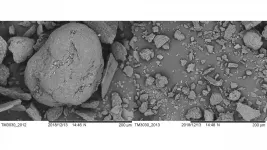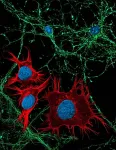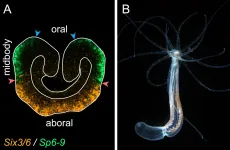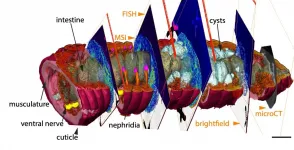(Press-News.org) This press release is in support of a presentation by Dr Ruth Howie presented online at the 37th Annual Meeting of ESHRE.
29 June 2021: Cancer treatments can cause premature ovarian failure (POI) including in girls who want to become mothers eventually. Ovarian tissue cryopreservation (OTC) provides a future fertility option but is invasive, has risks and evidence indicates that most girls don't develop POI. So, doctors face the dilemma of how to offer OTC appropriately.
Now, an assessment tool has been found to help predict correctly which female cancer patients aged under 18 years will develop POI and should therefore be offered OTC. Results from a long-term follow-up study of 423 girls and young women show nearly a quarter (24%; n = 9) of the 37 assessed as high risk by this method - known as the Edinburgh selection criteria - were later diagnosed with POI. This compares with only 3% who developed POI out of the 386 identified to be at low-risk.
Principal investigator Dr Ruth Howie, from the University of Edinburgh and NHS Lothian, will present the findings today online at the 37th Annual Meeting of ESHRE. She said that although prevalence of POI after childhood cancer is low at around 10%, the Edinburgh selection criteria (see notes) "are a robust tool for selecting those at high risk at the time of diagnosis who should be offered OTC".
She added: "Cancer treatments, especially aggressive chemotherapy and radiotherapy, can cause permanent damage to ovaries. Future fertility and reproductive health should be considered at time of diagnosis and treatment planning.
"Correct identification of patients at high risk allows appropriate discussion of fertility preservation with OTC and future transplantation."
The Edinburgh selection criteria for OTC have been in use since 1996 and were developed by a multidisciplinary group of experts. The criteria are based on knowledge of relevant scientific literature and clinician experience of POI. This report represents the longest follow-up to date to validate the selection method.
Overall, a total of 26 patients of the 37 offered OTC chose to actually have the procedure.
Data are based on all females under 18 years old and diagnosed with cancer in South East Scotland between 1 January 1996 and 30 April 2020. Reproductive function was assessed by the presence of menstruation, pregnancy, hormonal measurements, evidence of puberty or POI diagnosis at most recent follow-up to October 2020. The average time in the study for developing POI was 5.8 years, although many patients will develop the condition immediately after cancer treatment.
Of the 639 diagnosed, a total of 216 were excluded including those on hormonal contraception, girls aged under 12 because they were likely to be prepubertal and unable to have accurate assessment of current reproduction function, and those who had died before age 12.
The 423 remaining included a significant number (n = 143) with unknown reproductive outcomes. Dr Howie said this is likely to reflect "a lack of recording of normal menstrual function" in oncology and haematology clinics.
To address this, a subgroup analysis of 280 patients was carried out in addition to the main analysis. A total of 29 of the 280 were assessed as high risk of POI and offered OTC, and 31% (n = 9) of these developed the condition. This compares with 4% (n = 11) of the 251 patients assessed as low-risk.
Howie says the findings demonstrate that the Edinburgh criteria are successful at identifying "those at risk of developing a life changing and long-term effect". However, she added that the criteria should be continuously appraised via long-term follow up of the reproductive outcomes of those assessed. This is to ensure OTC is offered selectively.
INFORMATION:
Presentation 0-177, Tuesday 29 June 2021
Long-term follow up to assess criteria for ovarian tissue cryopreservation for fertility preservation in young women and girls with cancer
Notes on the Edinburgh selection criteria for OTC
- Age younger than 35 years
- No previous chemotherapy or radiotherapy if aged 15 years or older at diagnosis, but mild, non-gonadotoxic chemotherapy acceptable if younger than 15 years
- A realistic chance of surviving for 5 years
- A high risk of premature ovarian insufficiency (>50%)
- Informed consent (from parents and, where possible, patient)
- Negative serology results for HIV, syphilis, and hepatitis B
- Not pregnant and no existing children
* When obtaining outside comment, journalists are requested to ensure that their contacts are aware of the embargo on this release.
WASHINGTON, June 29, 2021 - For more than 60 years, algae have been studied as a potential feedstock for biofuel production, but the cellulose in their cell wall makes it hard to access the critical molecules inside and convert them to biogas.
In the Journal of Renewable and Sustainable Energy, from AIP Publishing, an international research team reports their success in using urea and sodium hydroxide (NaOH, commonly known as lye or caustic soda) as a pretreatment of algae, which breaks down cellulose and more than doubles biogas production under their initial experimental conditions.
"We were ...
With advances in medical science driving progress against childhood brain tumors, today three out of four young patients survive at least five years beyond diagnosis. However, the outcomes look grim when malignant cells spread, or metastasize.
Such is the case with medulloblastoma, a type of brain cancer that arises in the cerebellum, at the back of the head. Although rare in absolute terms -- about 350 cases emerge each year, 60 percent of them in children -- medulloblastoma is the most common and deadliest form of pediatric brain cancer. Metastasis ...
In a new article in Nature Communications, a research group led by Grigory Genikhovich at the University of Vienna has found that the way the main body axis of sea anemones is patterned by different intensities of β-catenin signaling is similar to that of sea urchins and vertebrates. This suggests that this axial patterning mechanism already existed about 650 million years ago.
The positioning of all anatomical structures in an embryo is determined by systems of molecular coordinates, which are called body axes. Different regulatory genes are activated at specific locations along the body axes to drive the development of all body parts in correct places.
This process is very ...
Ludwig-Maximilians-Universitaet (LMU) in Munich researchers have shown how RNA-binding proteins modulate synaptic responses that mediate the transmission of nerve cell impulses.
Cells in the central nervous system possess a high degree of flexibility, which enables them to adapt to fluctuating demands and respond to changing patterns of neuronal activity. This is achieved by modulating the connections between nerve cells, which are mediated by structures called synapses that determine how neighboring neurons respond to stimulation. These adjustments in turn require the intracellular transport of mRNAs. Consequently, the required proteins ...
Earthworms experience constant chemical interactions with bacteria, fungi, plants and small invertebrates across soil ecosystems. Even within their tissues, earthworms harbor symbiotic microbes and small animal parasites that trigger internal metabolic responses such as innate immunity. To reveal the fundamental processes that enable animal-microbe symbioses to form and persist, we have to study their metabolic interactions in situ. By combining novel imaging techniques, a team of researchers around Benedikt Geier from the Max Planck Institute for Marine Microbiology ...
Skoltech researchers and their colleagues from Russia and the UK investigated the safety and efficacy of new chemistry in antisense oligonucleotides used to treat spinal muscular atrophy (SMA), a debilitating genetic disease. Their results may lead to the development of drugs with less toxicity and fewer injections needed thanks to prolonged action. The paper was published in the journal Nucleic Acid Therapeutics.
Antisense oligonucleotides are single stranded chemically modified fragments of DNA that target pre-messenger RNA, short bits of genetic information a ribosome reads to make a protein. Depending on how a particular antisense oligonucleotide works, the target mRNA can either be destroyed or undergo subtle changes in how it's spliced, i.e. how exons, the ...
Russian scientists have experimentally proved the existence of a new type of quasiparticle - previously unknown excitations of coupled pairs of photons in qubit chains. This discovery could be a step towards disorder-robust quantum metamaterials. The study was published in Physical Review B.
Superconducting qubits are a leading qubit modality today that is currently being pursued by industry and academia for quantum computing applications. However, the performance of quantum computers is largely affected by decoherence that contributes to a qubits extremely short lifespan and causes computational errors. Another ...
Pioneering research has revealed the erosion of ancient sediments found deep beneath Antarctic ice could be a vital and previously unknown source of nutrients and energy for abundant microbial life.
The study, led by the University of Bristol and published today in Nature's Communications Earth & Environment journal, sheds new light on the many compounds supporting various microbes which form part of a huge subglacial ecosystem.
Lead author Dr Beatriz Gill Olivas, a Post-Doctoral Research Associate at the University of Bristol, said: "Although the study focused on samples obtained from a single ...
During summer 2020, the Yangtze River basin experienced persistent, record-breaking meiyu rainfall. Likewise, the region suffered from severe flooding and water damage as accumulated rainfall broke records dating back to 1954. Regions outside the meiyu rain belt received significant summer rainfall as well, including Beijing, located in northeastern China.
Typically, an above average meiyu rainfall season follows a strong El Niño during the previous winter. However, summer 2020 followed a neutral El Niño-Southern Oscillation (ENSO) event. Therefore, scientists are working ...
A stimulating environment keeps the "hippocampus" - which is the brain's memory control center - young, so to speak. Causes of this are molecular mechanisms that affect gene regulation. These current findings from studies in mice provide clues as to why an active, varied life can help preserve mental fitness in old age. Researchers from the DZNE and the Center for Regenerative Therapies Dresden (CRTD) at the Technische Universität Dresden report on this in the journal Nature Communications.
Human DNA - and this also applies to mice - contains thousands of genes. However, it is not only the genetic blueprint that is decisive for the function of a cell and whether it is healthy or not, but above all which genes can be switched on or off. ...






